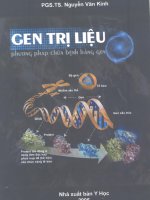Marine Geology Phần 1 potx
Bạn đang xem bản rút gọn của tài liệu. Xem và tải ngay bản đầy đủ của tài liệu tại đây (1015.58 KB, 34 trang )
Marine Geology
Jon erickson
Foreword by Timothy Kusky, PH.D.
Marine Geology
exploring the new frontiers
of the ocean
Revised edition
MARINE GEOLOGY
Exploring the New Frontiers of the Ocean, Revised Edition
Copyright © 2003, 1996 by Jon Erickson
All rights reserved. No part of this book may be reproduced or utilized in any form or by
any means, electronic or mechanical, including photocopying, recording, or by any
information storage or retrieval systems, without permission in writing from the publisher.
For information contact:
Facts On File, Inc.
132 West 31st Street
New York NY 10001
Library of Congress Cataloging-in-Publication Data
Erickson, Jon, 1948–
Marine geology: exploring the new frontiers of the ocean/Jon Erickson.—Rev. ed.
p. cm.—(The living earth)
Includes bibliographical references and index.
ISBN 0-8160-4874-6 (hardcover: alk. paper)
1. Submarine geology. 2. Marine biology. I.Title.
QE39 E68 2003
551.46’08—dc21 2002001295
Facts On File books are available at special discounts when purchased in bulk quantities for
businesses, associations, institutions, or sales promotions. Please call our Special Sales
Department in New York at 212/967-8800 or 800/322-8755.
You can find Facts On File on the World Wide Web at
Text design by Cathy Rincon
Cover design by Nora Wertz
Illustrations by Jeremy Eagle, © Facts On File
Printed in the United States of America
VB Hermitage 10987654321
This book is printed on acid-free paper.
CONTENTS
Tables vii
Acknowledgments ix
Foreword xi
Introduction xiii
1 THE BLUE PLANET: THE WORLD’S OCEANS
Origin of Sea and Sky
■ The Universal Sea ■ The Iapetus Sea ■
The Panthalassa Sea ■ The Tethys Sea ■ The Atlantic 1
2 MARINE EXPLORATION: DISCOVERIES
ON THE SEABED
Exploring the Ocean Floor
■ Surveying the Seabed ■
Geologic Observations ■ Ocean Drilling ■ Magnetic Surveys ■
Satellite Mapping 31
3 THE DYNAMIC SEAFLOOR: THE OCEANIC CRUST
Lithospheric Plates
■ Oceanic Crust ■ The Rock Cycle ■
Ocean Basins ■ Submarine Canyons ■ Microplates and Terranes 60
4 RIDGES AND TRENCHES: UNDERSEA MOUNTAINS
AND CHASMS
The Midocean Ridges
■ The Heat Engine ■ Seafloor Spreading ■
Basaltic Magma ■ The Circum-Pacific Belt ■
The Deep-Sea Trenches ■ Plate Subduction 87
5 SUBMARINE VOLCANOES: Eruptions
ON THE OCEAN FLOOR
The Ring of Fire
■ The Rising Magma ■ Island Arcs ■
Guyots and Seamounts ■ Rift Volcanoes ■ Hot-Spot Volcanoes ■
Volcanic Activity 114
6 ABYSSAL CURRENTS: OCEAN CIRCULATION
Rivers in the Abyss ■ El Niño ■ Abyssal Storms ■ Tidal Currents ■
Ocean Waves ■ Seismic Sea Waves 145
7 COASTAL GEOLOGY: THE ACTIVE COASTLINE
Sedimentation
■ Storm Surges ■ Coastal Erosion ■ Wave Impacts ■
Coastal Subsidence ■ Marine Transgression 172
8 SEA RICHES: RESOURCES OF THE OCEAN
Law of the Sea
■ Oil and Gas ■ Mineral Deposits ■
Energy from the Sea ■ Harvesting the Sea 201
9 MARINE BIOLOGY: LIFE IN THE OCEAN
Biologic Diversity ■ Marine Species ■ Life in the Abyss ■
Coral Reefs ■ The Vent Creatures ■ The Intertidal Zone 229
10 RARE SEAFLOOR FORMATIONS: UNUSUAL GEOLOGY
ON THE SEABED
Mud Volcanoes
■ Subsea Geysers ■ Submarine Slides ■
Sea Caves ■ Seafloor Craters ■ Undersea Explosions 257
Conclusion 285
Glossary 286
Bibliography 297
Index 305
1 The Geologic Time Scale 2
2 Radiation and Extinction of Species 10
3 Evolution of the Biosphere 12
4 The Major Ice Ages 13
5 Continental Drift 47
6 Comparison of Magnetic Reversals with Other Phenomena 56
7 Classification of the Earth’s Crust 66
8 The Amount of Carbon Relative to Life 72
9 History of the Deep Circulation of the Ocean 76
10 The World’s Ocean Trenches 107
11 Comparison of Types of Volcanism 115
12 Major Volcanic Disasters of the 20th Century 118
13 Classification of Volcanic Rocks 121
14 Major Tidal Bores 163
15 The Beaufort Wind Scale 179
tableS
VII
16 Major Changes in Sea Level 194
17 Natural Resource Levels 202
18 Productivity of the Oceans 226
19 Classification of Species 235
VIII
IX
T
he author thanks the National Aeronautics and Space Administration
(NASA), the National Oceanic and Atmospheric Administration
(NOAA), the U.S.Army Corps of Engineers, the U.S. Department of
Agriculture-Forest Service, the U.S. Department of Agriculture-Soil Conser-
vation Service, the U.S. Defense Nuclear Agency, the U.S. Department of
Energy, the U.S. Geological Survey (USGS), the U.S. Maritime Administra-
tion, the U.S. Navy, and the Woods Hole Oceanographic Institution (WHOI)
for providing photographs for this book.
The author thanks Frank K. Darmstadt, Senior Editor, and the rest of the
Facts On File staff for their invaluable contributions to the making of this book.
acknowledgments
O
ceans cover approximately two-thirds of the Earth’s surface, yet we
have explored less of the ocean’s depths and mysteries than the sur-
faces of several nearby planets.The oceans have inspired myths and
legends and have been the sources of intrigue, fear, and hope for thousands of
years. They have hindered migration of peoples and biota between distant
continents yet paradoxically now serve as a principal means of transportation.
Oceans provide us with incredible mineral wealth and renewable food and
energy sources yet also breed devastating hurricanes. Life on Earth may have
begun in environments around hot volcanic events on the seafloor, and we are
only beginning today to explore the diverse and unique fauna that thrive in
deep, dark waters around similar vents.
In the revised edition of Marine Geology, Jon Erickson explores several
ideas hypothesizing the origin of the Earth, continents, and oceans and how
these processes fit into the origin of the universe.The role of oceans and water
in the development of plate tectonics is discussed in detail, while the reader is
given essential information on how plate tectonics works. Ocean basins have
continually expanded and contracted on Earth, and the continents have alter-
nately converged into large single supercontinents and then broken apart by
the formation of new ocean basins.The appearance, evolution, and extinction
of different life-forms are inextricably linked to the expansion and contrac-
tion of ocean basins, partly through the changing environmental conditions
associated with tectonic processes.The history of several different ocean basins
over the past billion years is discussed in Marine Geology, as well as the chang-
ing life-forms in each successive ocean basin.
foreword
XI
Erickson presents a fascinating history of ocean exploration. He shows
how early explorations were slowly able to reveal data about ocean currents
and routes to distant lands and how some dredging operations uncovered
huge deposits of metals on the seafloor.Tremendous leaps in our understand-
ing of the structure and topography of the seafloor were acquired during sur-
veying for the navigation of submarines and detecting enemy submarines
during World War II. Magnetometers towed behind ships, and accurate depth
soundings provided data that led to the formulation of the hypothesis of
seafloor spreading, adding the oceanic counterpart to the idea of continental
drift.Together these two theories became united as the plate tectonic revolu-
tion. This sets the stage for succeeding chapters on the mid-ocean ridges,
deep-sea trenches, and submarine volcanoes.
Ocean circulation is responsible for much of the world’s climate. Mild
foggy winters in London are caused by warm waters from the Gulf of Mex-
ico flowing across the Atlantic in the Gulf Stream to the coast of the British
Isles. Large variations in ocean and atmospheric circulation patterns in the
Pacific lead to alternating wet and dry climate conditions known as El Niño
and La Niña.These variations affect Pacific regions most strongly but are felt
throughout the world.
Other movements of water are more dramatic, including the sometimes
devastating tsunami that may be initiated by earthquakes, volcanic eruptions, and
giant submarine landslides. One of the most tragic tsunami in recent history was
generated by the eruption of the Indonesian volcano Krakatau [Krakatoa] in
1883.When Krakatau erupted, it blasted out a large part of the center of the vol-
cano, and seawater rushed in to fill the hole. This seawater was immediately
heated, and it exploded outward in a steam eruption and a huge wave of hot
water. The tsunami generated by this eruption reached more than 120 feet in
height and killed an estimated 36,500 people in nearby coastal regions. In 1998
a catastrophic 50-foot-high wave unexpectedly struck Papua New Guinea,
killing more than 2,000 people and leaving more than 10,000 homeless.
The oceans are full of rich mineral deposits, including oil and gas on the
continental shelves and slopes and metalliferous deposits formed near mid-
ocean ridge vents. Much of the world’s wealth of manganese, copper, and gold
lies on the seafloor.The oceans also yield rich harvests of fish, and care must
be taken that we do not deplete this source by overfishing. Sea vegetables are
growing in popularity and their use may help alleviate the increasing demand
for space in fertile farmland.The oceans offer the world a solution to increas-
ing energy and food demands in the face of a growing world population. New
life-forms are constantly being discovered in the ocean’s depths, and under-
standing these creatures is necessary before any changes we make to their
environment causes them to perish forever.
— Timothy M. Kusky, Ph.D.
XII
Marine Geology
XIII
T
his planet contains so much water that perhaps it should have been
better named Oceania. It is the only known body in the solar system
that is surrounded by water filled with unique geologic structures and
teeming with a staggering assortment of marine life. Some of the strangest
creatures on Earth, whose ancestors go back several hundred million years, live
on the deep ocean floor. Many undersea ridges host an eerie world that time
forgot—a cold, dark abyss consisting of tall chimneys spewing hot, mineral-
rich water that supports unusual species previously unknown to science.
The floor of the ocean presents a rugged landscape unmatched any-
where on the continents. Vast undersea mountain ranges much more exten-
sive than those on land crisscross the seabed.Although deeply submerged, the
midocean ridges are easily the most prominent features on the planet. The
ocean floor is continuously being created at spreading ridges, where molten
rock oozes out of the mantle, and destroyed in the deepest trenches of the
world. Much of the world’s untapped wealth lies undersea.The seabed there-
fore offers new frontiers for future exploration of mineral resources.
An extraordinary number of volcanoes are hidden under the waves,
many more than on the land. Most of the volcanic activity that continually
remakes the surface of Earth occurs on the ocean floor. Active volcanoes ris-
ing up from the bottom of the ocean create the tallest mountains. Most of the
world’s islands in fact began as undersea volcanoes that broke the surface of
the sea. However, the preponderance of marine volcanoes is not exposed at
the surface but spread out on the ocean floor as isolated seamounts.
INTRODUCTION
Chasms that challenge the largest terrestrial canyons plunge to great
depths. Massive submarine slides gouge deep depressions into the seabed and
deposit enormous heaps of sediment onto the ocean floor. Undersea slides
also occasionally generate tall waves that pound nearby shores, causing much
destruction to seaside communities.Abyssal storms with strong currents sculpt
the ocean bottom, churning up huge clouds of sediment and dramatically
modifying the seafloor. The scouring of the seabed and deposition of large
amounts of sediment result in a highly complex marine geology.
This revised and updated edition is a much expanded and more inclu-
sive examination of the intriguing subject of marine geology. Science enthu-
siasts will particularly enjoy this fascinating subject and gain a better
understanding of how the forces of nature operate on Earth. Students of geol-
ogy and Earth science will also find this a valuable reference book to further
their studies. Readers will enjoy this clear and easily readable text that is well
illustrated with extraordinary photographs, detailed illustrations, and helpful
tables. A comprehensive glossary is provided to define difficult terms, and a
bibliography lists references for further reading. The geologic processes that
shape the surface of this planet are an example of the spectacular forces that
create the living Earth.
XIV
Marine Geology
T
his opening chapter chronicles the formation of Earth and the evolu-
tion of the oceans. Earth is unique among planets, because it is the
only body in the solar system with a water ocean and an oxygen
atmosphere. As many as 20 oceans have come and gone throughout this
planet’s long history (Table 1) as continents drifted apart from each other and
reconverged into supercontinents.The present oceans formed when a super-
continent named Pangaea, Greek for “all lands,” broke apart into today’s con-
tinents about 170 million years ago.
Prior to the breakup of Pangaea, a single large ocean called Panthalassa,
Greek for “universal sea,” surrounded the supercontinent. Before the assem-
blage of Pangaea, all continents surrounded an ancient Atlantic Ocean called
the Iapetus Sea. Deeper into the past, the continents again formed a super-
continent named Rodinia, Russian for “Motherland.” Its breakup created
entirely new seas, which participated in life’s greatest explosion of new
species. Life itself possibly evolved at the bottom of a global ocean not long
after Earth’s creation.
1
The Blue Planet
The World’s Oceans
1
2
Marine Geology
TABLE 1 THE GEOLOGIC TIME SCALE
Age (millions First
Era Period Epoch of years) Life-forms Geology
Holocene 0.01
Quaternary
Pleistocene 3 Humans Ice age
Cenozoic Pliocene 11 Mastodons Cascades
Neogene
Miocene 26 Saber-toothed tigers Alps
Tertiary Oligocene 37
Paleogene
Eocene 54 Whales
Paleocene 65 Horses, Alligators Rockies
Cretaceous 135
Birds Sierra Nevada
Mesozoic Jurassic 210 Mammals Atlantic
Dinosaurs
Triassic 250
Permian 280 Reptiles Appalachians
Pennsylvanian 310 Ice age
Trees
Carboniferous
Paleozoic Mississippian 345 Amphibians Pangaea
Insects
Devonian 400 Sharks
Silurian 435 Land plants Laursia
Ordovician 500 Fish
Cambrian 570 Sea plants Gondwana
Shelled animals
700 Invertebrates
Proterozoic 2500 Metazoans
3500 Earliest life
Archean 4000 Oldest rocks
4600 Meteorites
ORIGIN OF SEA AND SKY
An incredible amount of water resides in the solar system, much more than
on Earth alone. As the Sun emerged from gas and dust, tiny bits of ice and
rock debris gathered in a frigid, flattened disk of planetesimals surrounding the
infant star.The temperatures in some parts of the disk might have been warm
enough for liquid water to exist on the first solid bodies to form. In addition,
water vapor in the primordial atmospheres of the inner terrestrial planets
might have been eroded away by planetesimal bombardment and blown
beyond Mars by the strong solar wind of the infant Sun. Once planted in the
far reaches of the solar system, ice crystals coalesced into comets that returned
to Earth to supply it with additional water.
The creation of the Moon (Fig. 1) remains a mystery. Perhaps a Mars-sized
body slammed into Earth and splashed enough material into orbit to coalesce
into a daughter planet.The presence of a rather large moon, the biggest of any
moon in the solar system in relation to its mother planet, might have had a
major influence on the initiation of life. The unique properties of the Earth-
Moon system raised tides in the ocean. Cycles of wetting and drying in tidal
pools might have helped the planet acquire life much earlier than previously
thought possible.The Moon might also have been responsible for the relatively
Figure 1 The surface of
the Moon viewed from an
Apollo spacecraft showing
many of its terrain
features.
(Photo courtesy NASA)
3
The Blue Planet
stable climate. It might have made Earth hospitable to life by stabilizing the tilt
of the planet’s rotational axis, which marks the seasons.Without the Moon, life
on Earth would likely face the same type of wild fluctuations in climate that
Mars has apparently experienced through the eons.
Earth’s original crust was quite distinct from modern continental crust,
which first appeared about 4 billion years ago and represents less than 0.5 per-
cent of the planet’s total volume. During this time, Earth spun wildly on its
axis, completing a single rotation every 14 hours, thus maintaining high tem-
peratures throughout the planet. Present-day plate tectonic processes could
not have operated under such hot conditions, which produced more vertical
bubbling than horizontal sliding. Therefore, modern-style plate tectonic
processes were probably not fully functional until 2.7 billion years ago, when
the formation of the crust was nearly complete.
Earth apparently took less than half its history to form an equivalent vol-
ume of continental rock it has today. Information about the early crust is pro-
vided by some of the most ancient rocks that survived intact. They formed
deep within the crust a few hundred million years after the formation of the
planet and now outcrop at the surface. Zircon crystals (Fig. 2) found in gran-
ite are enormously resistant and tell of the earliest history of Earth, when the
Figure 2 Zircons from
the rare-earth zone, Jasper
cuts area, Gilpin County,
Colorado.
(Photo by E. J.Young,
courtesy USGS)
4
Marine Geology
crust first formed some 4.2 billion years ago.Among the oldest rocks is the 4-
billion-year-old Acasta gneiss,a metamorphosed granite in the Northwest Ter-
ritories of Canada. Its existence suggests that the formation of the crust was
well underway by this time.The discovery is used as evidence that at least small
patches of continental crust existed on Earth’s surface at an early date.
During Earth’s formative years, a barrage of asteroids and comets pounded
the infant planet and the Moon between 4.2 and 3.9 billion years ago.A swarm
of debris left over from the creation of the solar system bombarded Earth.The
bombardment might have delivered heat and organic compounds to the planet,
sparking the rapid formation of primitive life. Such a pummeling could also
have wiped out existing life-forms in a colossal mass extinction.
Comets comprising rock debris and ice also plunged into Earth, releas-
ing tremendous quantities of water vapor and gases. The degassing of these
cosmic invaders produced mostly carbon dioxide, ammonia, and methane,
major constituents of the early atmosphere, which began to form about 4.4
billion years ago. Most of the water vapor and gases originated from within
Earth itself by volcanic outgassing.The early volcanoes were extremely explo-
sive because Earth’s interior was hotter and the magma contained more abun-
dant volatiles than today.
Earth soon acquired a primordial atmosphere composed of carbon diox-
ide, nitrogen, water vapor, and other gases belched from a profusion of volca-
noes. Water vapor so saturated the air that atmospheric pressure was several
times greater than it is today. The early atmosphere contained up to 1,000
times the current level of carbon dioxide.This was fortunate because the Sun’s
output was only about 75 percent its present value, and a strong greenhouse
effect kept the oceans from freezing solid.The planet also retained heat by a
high rotation rate, with days only 14 hours long, and by the absence of con-
tinents to block the flow of ocean currents.
Oxygen originated directly from volcanic outgassing and meteorite
degassing. It also developed indirectly from the breakdown of water vapor and
carbon dioxide by strong ultraviolet radiation from the Sun. All oxygen gen-
erated by these methods quickly bonded to metals in the crust, much like the
rusting of iron. Oxygen also recombined with hydrogen and carbon monox-
ide to reconstitute water vapor and carbon dioxide. A small amount of oxy-
gen existing in the upper atmosphere might have provided a thin ozone
screen.This would have reduced the breakdown of water molecules by strong
ultraviolet rays from the Sun, thus preventing the loss of the entire ocean, a
fate that might have visited Venus eons ago (Fig. 3).
Nitrogen originated from volcanic eruptions and from the breakdown
of ammonia.The ammonium molecule, composed of one nitrogen atom and
three hydrogen atoms, is also a major constituent of the primordial atmos-
phere. Unlike most other gases, which have been replaced or recycled, Earth
5
The Blue Planet
retains much of its original nitrogen. This is because nitrogen readily trans-
forms into nitrate, which easily dissolves in the ocean.As a result, the denitri-
fying bacteria return the nitrate-nitrogen to its gaseous state. Therefore,
without life, Earth would have long ago lost its nitrogen and possess only a
fraction of its present atmospheric pressure.
The surface of Earth was scorching hot and in a constant rage. Winds
blew with tornadic force, producing fierce dust storms that raced across the dry
surface.The planet was blanketed with suspended sediment similar to Martian
dust storms today (Fig. 4). Huge lightning bolts darted back and forth. Earth-
shattering thunder sent gigantic shock waves reverberating through the air.
Volcanoes erupted in one gigantic outburst after another, lighting the sky with
white-hot sparks of ash and red-hot lava flowing across the land.
The restless Earth rent apart as massive quakes cracked open the thin crust
and huge batches of magma bled through the fissures.Voluminous lava flows
flooded the surface, forming flat, featureless plains dotted with towering volca-
noes. The intense volcanism also lofted massive quantities of volcanic debris
high into the atmosphere, giving the sky an eerie red glow.The dust also cooled
the planet and acted as particles upon which water vapor coalesced.
With a further drop in atmospheric temperatures, water vapor condensed
into heavy clouds that shrouded the planet.They completely blocked out the
Sun and plunged the surface into total darkness.As the atmosphere continued
to cool, sheets of rain fell from the sky. Deluge after deluge overflowed the
Figure 3 A view of
Venus’s northern latitudes
from the Russian Venera
spacecraft.
(Photo courtesy NASA)
6
Marine Geology
landscape. Raging floods cascaded down steep volcanic slopes and the sides of
large meteorite craters, gouging out deep ravines in the rocky plain.
Around 4 billion years ago, when the rains ceased and the skies finally
cleared, Earth emerged as a giant blue orb covered by a global ocean nearly 2
miles deep dotted with numerous volcanic islands. Countless volcanoes
erupted undersea. Hydrothermal vents spewed hot water containing sulfur
and other chemicals. Some volcanoes poked through the sea surface to emerge
as scattered islands, yet no continents graced Earth’s watery face.
Massive meteorite impacts continued to strike Earth, making living con-
ditions very difficult for life, which was first striving to organize proteins into
living cells. The first cells might have been repeatedly exterminated, forcing
life to originate again and again. Whenever primitive organic molecules
attempted to arrange themselves into living matter, frequent impacts blasted
them apart before they had a chance to reproduce.
Some large impactors might have generated enough heat to boil off a
large portion of the ocean repeatedly. The vaporized sea would have raised
surface pressures more than 100 atmospheres.The resulting high temperatures
would have sterilized the entire planet. Several thousand years elapsed before
Earth cooled sufficiently for steam to condense into rain and refill the ocean
basins once again, only to await the next ocean-evaporating impact. Such
harsh conditions could have set back the emergence of life hundreds of mil-
lions of years.
Perhaps the only safe place for life to evolve was on the deep ocean floor,
where a high density of hydrothermal vents existed. These vents acted like
geysers on the bottom of the sea (Fig. 5) and expelled mineral-laden hot water
heated by shallow magma chambers resting just beneath the ocean floor.The
vents might have created an environment capable of generating an immense
number of organic reactions and providing the ingredients and energy neces-
sary to create the planet’s first life. The vents would have also given evolving
Figure 4 The surface of
Mars view from Viking
Lander 2, showing a
boulder-strewn field with
rocks embedded in fine
sediment from Martian
dust storms.
(Photo courtesy NASA)
7
The Blue Planet
life-forms all the essential nutrients needed to sustain themselves. Indeed, such
an environment exists today and is home to some of the strangest creatures
found on Earth. In this environment, life could have originated as early as 4.2
billion years ago.
Evidence for life early in Earth’s history, when the planet was still quite
hot, exists today as thermophilic (heat-loving) bacteria. They are found in
thermal springs and other hot-water environments throughout the world (Fig.
6) as well as deep underground or far beneath the ocean floor. Archaebacte-
ria, or simply archaea, range widely throughout the seas. Many parts of the
ocean are teeming with them. One-third of the biomass of picoplankton (the
tiniest plankton) in Antarctic waters comprises archaea. Such abundance could
mean that archaea play an important role in the global ecology and might have
a major influence on the chemistry of the ocean.
THE UNIVERSAL SEA
The early Earth was mostly ocean. Continental crust comprised slivers of
granite that drifted freely over the surface and was perhaps only one-tenth its
Figure 5 Hydrothermal
vents on the deep ocean
floor provide nourishment
and heat for bottom
dwellers.
(Photo courtesy USGS)
8
Marine Geology
current size. Between the end of the great meteorite bombardment and the
formation of the first sedimentary rocks about 3.8 billion years ago, large vol-
umes of water flooded Earth’s surface. Seawater probably began salty due to
the volcanic outgassing of chlorine and sodium. However, the ocean did not
contain its present concentration of salts until about 500 million years ago.The
salt level has remained generally constant ever since. Yet the ocean has not
always been consistent. Major changes in seawater chemistry often correlate
with biologic extinction (Table 2).
In a remote mountainous area in southwest Greenland, metamorphosed
marine sediments of the Isua Formation provide strong evidence for an early
saltwater ocean.The Isua rocks originated in volcanic island arcs and therefore
lend credence to the idea that plate tectonics operated early in the history of
Earth.The rocks are among the most ancient, dating to about 3.8 billion years,
and indicate that the planet had abundant surface water by this time. Earth’s
oldest sedimentary rocks also contain chemical fingerprints of complex cells
that originated as early as 3.9 billion years ago.
Most of the crust was deeply submerged during the Archean, as evidenced
by an abundance of chert deposits more than 2.5 billion years old. Chert is
among the hardest minerals. Some appears to have precipitated from silica-rich
water in deep oceans. The seas contained abundant dissolved silica, which
leached out of volcanic rock pouring onto the ocean floor. Modern seawater is
deficient in silica because organisms such as diatoms extract it to build ornate
skeletons (Fig. 7). Massive deposits of diatomaceous earth, or diatomite, are a
tribute to the great success of these organisms during the last 600 million years.
Figure 6 Boiling mud
springs northwest of
Imperial Junction,
California.
(Photo by W. C.
Mendenhall, courtesy
USGS)
9
The Blue Planet
Sulfur from volcanoes was particularly abundant in the early ocean and
combined easily with metals such as iron to form sulfates. Biochemical activ-
ity in the ocean was also responsible for stratified sulfide deposits. Sulfur-
metabolizing bacteria living near undersea hydrothermal vents oxidized
hydrogen sulfide into elemental sulfur and various sulfates. Copper, lead, and
zinc, which were much more abundant in the Proterozoic than in the
Archean, also reflect a submarine volcanic origin.
The earliest organisms were sulfur-metabolizing bacteria similar to those
living symbiotically in the tissues of tube worms near sulfurous hydrothermal
vents on the East Pacific Rise and on a dozen other midocean ridges scattered
around the world.Abundant sulfur in the early sea provided the nutrients to sus-
tain life without the need for oxygen. Bacteria obtained energy by the reduction
(opposite of oxidation) of this important element.The growth of primitive bac-
teria was also limited by the amount of organic molecules produced in the ocean.
Oxygen was practically nonexistent when life first appeared (Table 3).
Oxygen levels remained low because of the oxidation of dissolved metals in
seawater and reduced gases emitted from submarine hydrothermal vents.The
seas contained abundant iron, which reacted with oxygen generated by pho-
tosynthesis. This was a fortunate circumstance since oxygen was also poiso-
10
Marine Geology
TABLE 2 RADIATION AND EXTINCTION OF SPECIES
Organism Radiation Extinction
Mammals Paleocene Pleistocene
Reptiles Permian Upper Cretaceous
Amphibians Pennsylvanian Permian-Triassic
Insects Upper Paleozoic
Land plants Devonian Permian
Fish Devonian Pennsylvanian
Crinoids Ordovician Upper Permian
Trilobites Cambrian Carboniferous & Permian
Ammonoids Devonian Upper Cretaceous
Nautiloids Ordovician Mississippian
Brachiopods Ordovician Devonian & Carboniferous
Graptolites Ordovician Silurian & Devonian
Foraminiferans Silurian Permian & Triassic
Marine invertebrates Lower Paleozoic Permian









